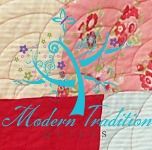Thanks to the photo editor PicMonkey for helping me crop these images down. These photos were taken from quilts I've done for myself or customers and needed to be cropped to zero-in on the thread paths.
While this post is different as I decided to draw the arrows of thread-paths on the photos themselves, the same following and practicing techniques apply. As with all of my pantographs, the starting point is marked with a red star and the exit is marked with a blue smaller star. Trace the panto in the order of the numbers following the direction the arrows indicate. To practice them for long-arm style machine quilting, trace the panto initially, then repeatedly sketch until you're comfortable on a dry-erase board. If you use sit-down or domestic style machine quilting, have someone hold a dry-erase marker vertical and in the same spot for you. Then move the dry-erase board around repeatedly until you feel comfortable with the motif.
Flying geese are usually part of larger blocks such as these. This post will show you how to break down a basic thread-path. For more information on continuous curve quilting with swirls, visit my older post KISMIF #3--QBOMS.
To quilt this thread-path, start at the corner star, continuous curve around the flying geese unit following the numbers, swirl in the diagonals shown in blue numbers 6 & &, then continuous curve back to number 8. This one is easy, looks great, but really at a "beginner" level of complexity.
Here is another beginner level:
 |
| This is the over-all block. |
The next three pictures are from a post I did about the Underground Railroad Quilts for a local quilting group. The underlined link will show you their quilts in full.
And another beginner:
The outside half-square triangle (HST) in the brown fabric is easy and fast. Start by stitching in the ditch from the star until you meet the center point, swirl #2 and #3--really easy then ditch over to the second star. Using the flying geese unit as your guide, simply loop the loop of varying sizes across the rows of HSTs. When you reach the edge, stitch in the ditch over to the last HSTs. It's fun, cute, easy and fast! KISMIF!
Now...lets get "tricky"! This one I would rate as "intermediate."
Now...lets add feather plumes! This is also an intermediate level of intensity. For this demo, I assume the reader knows how to make a feather plume. If not, I'll treat it in a future post--just let me know if it's something you're interested in! :)
As always, start at the star, do feather plumes 1 & 2. Stitch in the ditch over to the mini-star and follow the basic continuous curve pathways going through the numbers. If you notice, this example's pathway is actually up-side down from the "beginner" ones listed above. At number 7, ditch over to complete the plumes. To repeat this motif in the next flying geese unit, ditch over to the next corner. It will be done going in reverse order as initially, we started at the bottom and now are at the top.
And...for some advanced examples! These "bump-back" feather motifs/traditional feather motifs are marked using a pounce-pad and then filled in using free-motion quilting. However, I don't do the "bump-back" because I do not have a stitch regulated machine. Instead, I meander out, do some FMQ and then jump back in to finish the motif. To draw the thread-paths of these would take another entire post! If you're interested, let me know!
I hope this gives you some fun ideas for your next quilting project!
Happy Quilting! BTW, check out my quilt patterns! They can be purchased from Craftsy, Etsy, Connecting Threads, PatternSpot or Farm Fresh Fabrics. All of these shops are linked on my LHS side bar. Also check out my RHS for great linky parties! I share this post reguarly with Quilt Story, Free Motion by the River, WiP Wednesday & Crazy Mom Quilts blogs!







































.jpg)

.jpg)


.jpg)
.jpg)
.jpg)






